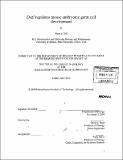Dazl regulates mouse embryonic germ cell development
Author(s)
Gill, Mark E
DownloadFull printable version (10.91Mb)
Other Contributors
Massachusetts Institute of Technology. Dept. of Biology.
Advisor
David C. Page.
Terms of use
Metadata
Show full item recordAbstract
In the mouse, germ cells can undergo differentiation to become either oocytes or spermatozoa in response to sex of their gonadal environment. The nature of the germ cell-intrinsic aspects of this signaling have not been well studied. The earliest known sex-specific difference in germ cells is the initiation of meiosis in female, but not male, embryonic germ cells. Experiments were performed showing that germ cells of both sexes transit through a state, the meiosis competent germ cell, that is required for initiation of meiosis. Acquisition of this state requires the function of the germ cellspecific RNA binding protein DAZL. The sufficiency for the absence of meiosis to drive male germ cell differentiation was then tested by examining non-meiotic XX germ cells in the Dazl-deficient ovary. These cells did not exhibit male differentiation indicating that the absence of meiosis is not sufficient for male differentiation. XX Dazl-deficient germ cells also failed to exhibit normal female differentiation. In addition, XY Dazl-deficient germ cells do not display characteristics of either male or female germ cells. Taken together, these results indicate that germ cells must first undergo a sex non-specific differentiation step prior to acquiring sexual fate.
Description
Thesis (Ph. D.)--Massachusetts Institute of Technology, Dept. of Biology, 2010. Cataloged from PDF version of thesis. Includes bibliographical references.
Date issued
2010Department
Massachusetts Institute of Technology. Department of BiologyPublisher
Massachusetts Institute of Technology
Keywords
Biology.